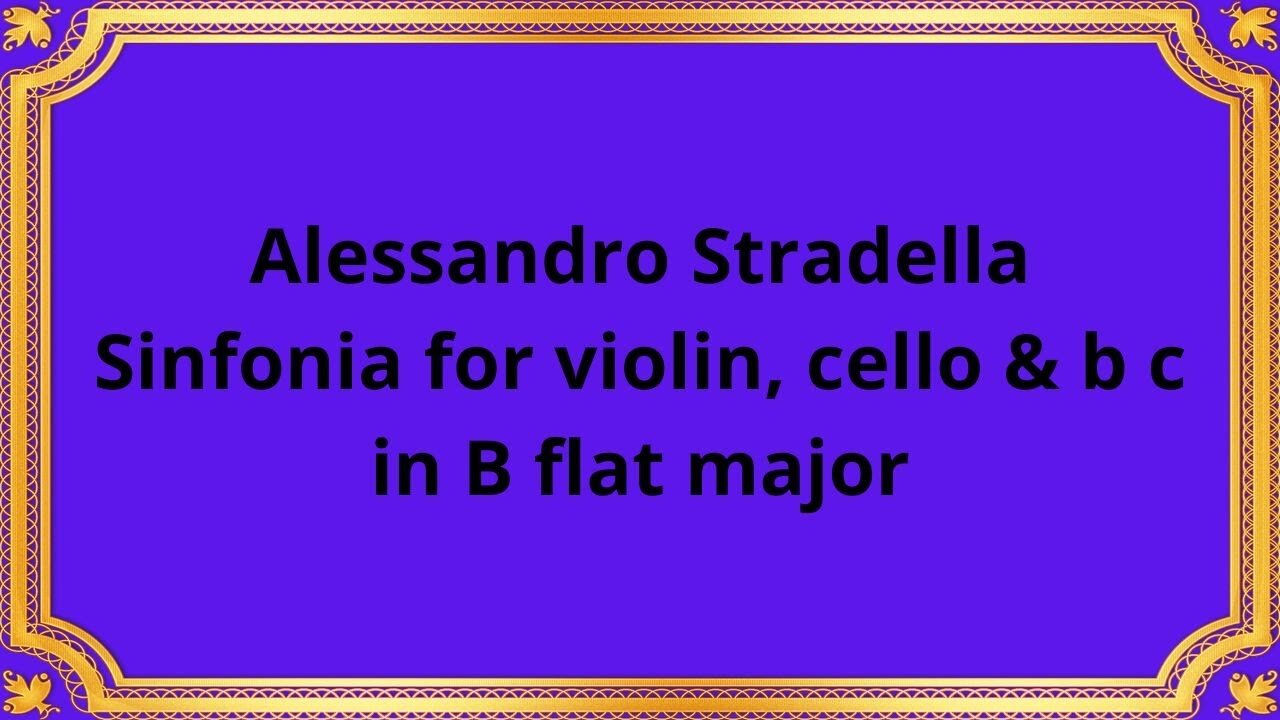Premium Only Content

Alessandro Stradella Sinfonia for violin, cello & b c in B flat major
#AlessandroStradella #Sinfonia #Violin #Cello #BassoContinuo #BFlatMajor #ClassicalMusic #MusicalComposition #BaroqueEra #ItalianComposer #InstrumentalMusic
Publication date 1954
Trio di Bolzano
Nunzio Montanari (piano)
Giannino Carpi (violin)
Antonio Valisi (’cello)
Alessandro Stradella, an esteemed Italian composer of the Baroque era, left an enduring legacy in the world of classical music. His Sinfonia for Violin, Cello & Basso Continuo in B flat major is a remarkable composition that showcases his mastery of instrumental music.
The Baroque era, known for its ornate and richly textured musical style, serves as the backdrop for Stradella's Sinfonia. As a prominent composer of his time, Stradella played a significant role in shaping the musical landscape, and this composition is a testament to his innovative and expressive approach to instrumental music.
The Sinfonia for Violin, Cello & Basso Continuo in B flat major is a captivating composition that beautifully combines the voices of the violin, cello, and basso continuo to create a harmonious and enchanting musical experience.
1. Adagio - Allegro:
The piece begins with an Adagio introduction, which sets a contemplative and introspective mood. The violin and cello engage in a delicate and expressive dialogue, supported by the gentle harmonies of the basso continuo. This section seamlessly transitions into an Allegro movement, where the tempo quickens and the music becomes more lively and spirited. Stradella's use of intricate melodic lines and virtuosic passages showcases his ability to create engaging and dynamic musical conversations between the instruments.
2. Andante:
Following the energetic Allegro, the Andante movement provides a serene and lyrical interlude. The violin and cello weave together melodic lines that evoke a sense of tranquility and beauty. Stradella's use of expressive ornamentation and delicate phrasing adds depth and emotion to this section, creating a captivating musical landscape.
3. Allegro finale:
The final movement, marked Allegro, brings the Sinfonia to a thrilling conclusion. Stradella's skillful manipulation of rhythms and harmonies creates a sense of excitement and anticipation. The violin and cello engage in virtuosic passages, showcasing their technical prowess and the composer's ability to push the boundaries of instrumental music. The piece concludes with a resounding and triumphant finale, leaving the listener captivated by Stradella's musical brilliance.
Conclusion:
Alessandro Stradella's Sinfonia for Violin, Cello & Basso Continuo in B flat major stands as a testament to the composer's remarkable talent and innovation in the realm of instrumental music. Through its thoughtful structure and expressive melodies, the Sinfonia captivates listeners with its intricate interplay between the violin, cello, and basso continuo. Stradella's ability to evoke a range of emotions, from introspection to excitement, makes this composition a treasured addition to the repertoire of classical music. As we continue to appreciate and explore this magnificent work, we gain a deeper understanding of Stradella's significant contribution to the rich tapestry of classical music.
You have the opportunity to support the channel:
https://destream.net/live/RadSiarAl/donate
https://www.buymeacoffee.com/6355radsiaral
-
 6:07
6:07
Classical music_Music Inspiration
5 days agoJoseph Haydn Piano Sonata in D Major, Hob. XVI:51
331 -
 46:26
46:26
State of the Second Podcast
15 hours agoATF tries to Silence FREE SPEECH? (ft. AmmoLand)
1.23K1 -
 12:53
12:53
BIG NEM
11 hours agoI Became a Virginity Expert. The Numbers Will SHOCK You.
1.74K -
 7:51
7:51
PerpetualHealthCo
19 hours agoW.H.O's In Charge?
1491 -
 1:09:34
1:09:34
PMG
14 hours agoDoomsday Clock Moves Toward Midnight!!! Is The End Coming Sooner Than We Thought?!
3431 -
 3:03:51
3:03:51
FreshandFit
9 hours agoShe BRAGGED About Her ABORTIONS?!
85.3K96 -
 1:45:26
1:45:26
Kim Iversen
14 hours agoBANNED for Telling the Truth: The 9/11 and Epstein Plot They Don't Want You To Hear
156K242 -
 1:08:47
1:08:47
Man in America
16 hours agoDr. Makis EXPOSES Big Pharma’s SICK Vaccine Scam—RFK Jr. Must Act NOW!
121K45 -
 1:28:21
1:28:21
Glenn Greenwald
14 hours agoRFK Jr. Hearing Reveals DC Pro-Pharma Consensus; Trump's Executive Order to Deport Student Protesters Criticizing Israel; Untangling DC Think Tank Funding & Influence | SYSTEM UPDATE #399
166K181 -
 1:23:44
1:23:44
Space Ice
15 hours agoSpace Ice & Redeye: Van Damme's The Quest: Pirates, Clowns, James Bond & Bloodsport
52.4K3